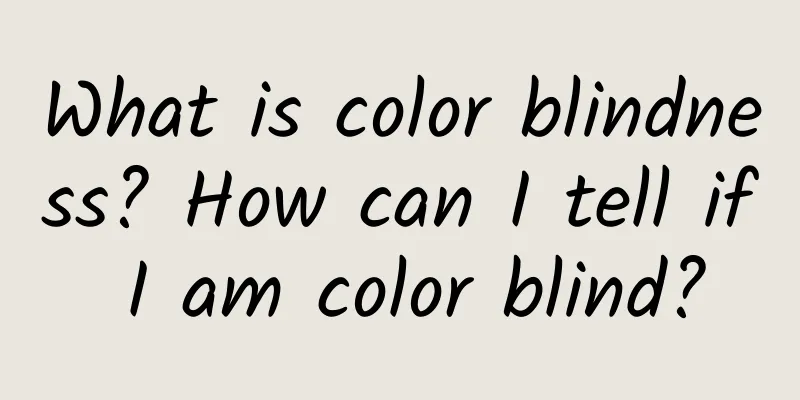What is color blindness? How can I tell if I am color blind?

|
Most color blindness patients are born with this condition and there is no effective treatment. The patients’ ability to distinguish colors is reduced. Although they can see the colors that normal people can see, their ability to distinguish colors becomes slower. So, what is color blindness? How do you determine if you are color blind? What are the categories of color blindness? Let’s learn more about it with Encyclopedia Knowledge Network! Contents of this article
What is color blindnessColor deficiency is a color vision disease caused by various factors. The patient's ability to distinguish colors is reduced. Although they can see the colors that normal people can see, the ability to distinguish colors becomes slow. In dim light conditions, sometimes colors cannot be distinguished, which is close to color blindness. When the light is obvious or the colors of objects are bright, colors can be distinguished normally, which is close to that of normal people. How to determine if you are color blind1. Hue arrangement detection Under fixed lighting conditions, the doctor will ask the patient to classify and arrange objects or cards of the same size and shape but different colors by color, and put objects with the closest colors together. The doctor will judge the nature and degree of the patient's color vision disorder based on whether the arrangement order is normal or not. 2. Check with a color vision mirror NagelⅠ color blindness mirror is the gold standard for diagnosing congenital red and green color vision abnormalities. It can determine the specific type and degree of color vision abnormalities and the type and degree of color vision defects. The NagelⅡ color blindness mirror contains blue and green to match blue-green, which is used to detect blue vision abnormalities, and can be used to determine the type and degree of color vision defects. 3. Imaging examination For non-congenital patients, if the doctor suspects that the patient's color blindness is caused by cranial and brain diseases, the doctor may also perform head CT, MRI and other examinations on the patient to observe whether there are cranial and brain lesions. 4. False color chart inspection Usually called a color blind book, it uses dots of the same shade but different colors to form numbers or graphics, and is read at a distance of 50cm under natural light. The color blind book should be placed upright during the inspection, and each picture should not exceed 5 seconds. People with color vision impairment have difficulty in identification, read incorrectly or cannot read, and can confirm which color vision abnormality they have according to the color blindness table. Under white light, if the patient is at a distance of 50cm and can identify correctly within 5 seconds, then the color vision is normal, and if the time is extended, then the color is weak. What are the types of color blindness?1. Red weakness The ability to distinguish red is weak, orange, red, and yellow look like green, and colors appear darker. 2. Weak blue and yellow The patient feels that blue looks like green, and yellow looks like light gray or purple. This type of condition is relatively rare. 3. Green weakness The ability to distinguish green is weak, yellow and green look like red, and blue and purple cannot be distinguished. This type is the most common. 4. Panchromatosis The patient has a reduced ability to distinguish all colors, but no abnormal vision. Compared with total color blindness, patients with total color deficiency do not have eye symptoms such as photophobia and nystagmus, and are less common in clinical practice. What is the difference between color weakness and color blindness?Both color blindness and color weakness will have a certain impact on the patient's daily life. The difference between the two lies in the degree of recognition disorder. The former is mainly manifested as the complete inability to distinguish one or more colors, while color-weak patients only have a reduced ability to distinguish one or more colors. They can recognize and distinguish all colors, but it takes longer. For example, when recognizing a specific pattern on a color blind book, a normal person can correctly recognize it within 5 seconds, a color-weak patient will recognize it after a longer period of time, and a color blind patient cannot recognize it at all, so the two can be easily distinguished based on this property. |
<<: What is pseudomyopia? What are the symptoms of pseudomyopia?
>>: What is the material of ice silk mat? How to clean and maintain ice silk mat
Recommend
What does plum blossom wine taste like? What are the methods for making plum blossom wine?
Plum blossoms are native to southern China and ha...
Can excessive stress cause delayed menstruation?
Every woman has experienced irregular menstruatio...
What is the best thing for a woman to eat after miscarriage?
For women, it is important to avoid miscarriage a...
Can pregnant women do ani exercises?
Pregnant women can do ani lifting exercises befor...
Why is the leucorrhea slightly yellow?
Slightly yellow leucorrhea is actually a sign of ...
Questions and Answers on the Dietary Guidelines for Growth Stunting in Children and Adolescents (2023 Edition)
Recently, the National Health Commission issued t...
What does cin mean?
Cervical intraepithelial neoplasia, commonly know...
What causes vaginal odor?
The vagina is a very important part unique to wom...
How to exercise the female vagina
Nowadays, women's physical fitness is general...
What are the symptoms of high blood pressure in women?
Hypertension is a major problem that endangers hu...
My period has been here for ten days and it's still not over
Generally speaking, when menstruation comes, ther...
What is the cause of a round lump on the breast during lactation?
It is critical for women to take care of their br...
What to do if your hair is naturally curly
There are differences in hair and eye color among...
The beginning of spring has arrived, let your children thrive with the energy of heaven and earth!
The air is cool, but it cannot resist the footste...









